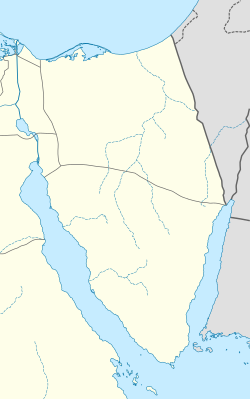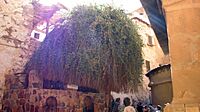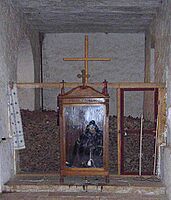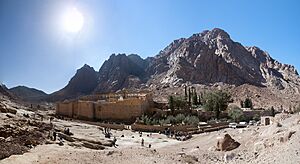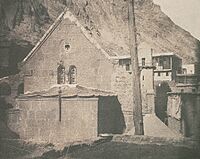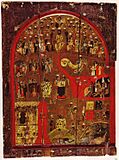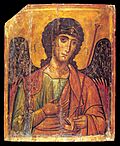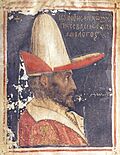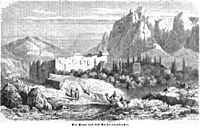Saint Catherine's Monastery facts for kids
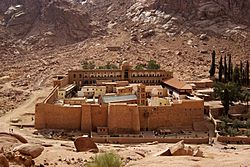
General view of Saint Catherine's Monastery, looking down from Mount Sinai
|
|
| Monastery information | |
|---|---|
| Full name | Sacred Autonomous Royal Monastery of Saint Catherine of the Holy and God-Trodden Mount Sinai Greek: Ιερά Αυτόνομος Βασιλική Μονή Αγίας Αικατερίνης του Αγίου και Θεοβαδίστου Όρους Σινά |
| Other names | Monastery of Saint Katherine Moni tis Agias Aikaterinis |
| Order | Church of Sinai |
| Denomination | Greek Orthodox Church |
| Established | AD 565 |
| People | |
| Founder(s) | Justinian I |
| Site | |
| Location | Saint Catherine, South Sinai Governorate, Egypt |
| Country | Egypt |
| Coordinates | 28°33′20″N 33°58′34″E / 28.55556°N 33.97611°E |
| Visible remains | Catherine of Alexandria |
| Official name: Saint Catherine Area | |
| Type: | Cultural |
| Criteria: | i, iii, iv, vi |
| Designated: | 2002 (26th session) |
| Reference #: | 954 |
| Region: | Arab States |
Saint Catherine's Monastery (Arabic: دير القدّيسة كاترين Dayr al-Qiddīsa Katrīn; Greek: Μονὴ τῆς Ἁγίας Αἰκατερίνης), officially the Sacred Autonomous Royal Monastery of Saint Catherine of the Holy and God-Trodden Mount Sinai, is a Christian monastery located in the Sinai Peninsula of Egypt. Located at the foot of Mount Sinai, it was built between 548 and 565, and is the world's oldest continuously inhabited Christian monastery.
The monastery was built by the orders of the Byzantine emperor Justinian I, enclosing what is claimed to be the burning bush seen by Moses. Centuries later, the purported body of Saint Catherine of Alexandria, said to have been found in the area, was taken to the monastery; Saint Catherine's relics turned it into an important pilgrimage site, and the monastery was eventually renamed after the saint.
Controlled by the autonomous Church of Sinai, which is part of the wider Greek Orthodox Church, the monastery became a UNESCO World Heritage Site in 2002 for its unique importance in the traditions of Christianity, Islam, and Judaism.
The site also holds the world's oldest continually operating library, with unique or extremely rare works, such as the Codex Sinaiticus and the Syriac Sinaiticus, as well as possibly the largest collection of early Christian icons, including the earliest known depiction of Jesus as Christ Pantocrator.
Saint Catherine's has as its backdrop the three mountains it lies near: Ras Sufsafeh (possibly the Biblical Mount Horeb, peak c.1 km (0.62 mi) west); Jebel Arrenziyeb, peak c.1km south; and Mount Sinai (locally, Jebel Musa, by tradition identified with the biblical Mount Sinai; peak c. 2 km (1.2 mi) south).
Contents
Christian traditions
The monastery was built around the location of what is traditionally considered to be the place of the burning bush seen by the prophet Moses. Saint Catherine's monastery also encloses the "Well of Moses", where Moses is said to have met his future wife, Zipporah. The well is still today one of the monastery's main sources of water. The site is sacred to Christianity, Islam, and Judaism.
Centuries after its foundation, the body of Saint Catherine of Alexandria was said to be found in a cave in the area. Catherine was a popular saint in Europe during the Middle Ages; her story says that, for defending Christianity, she was sentenced to death.
The relics of Saint Catherine, kept to this day inside the monastery, have made it a favourite site of pilgrimage. The patronal feast of the monastery is the Feast of the Transfiguration.
-
The monastery's centuries-old bramble is considered to be the biblical burning bush.
-
"Well of Moses", where Moses is said to have met his future wife, Zipporah
-
Skeleton of the monk Stephanos, in his robe, in front of the ossuary
History
The oldest record of monastic life at Mount Sinai comes from the travel journal written in Latin by a pilgrim woman named Egeria (Etheria; Saint Sylvia of Aquitaine) about 381/2–386.
The monastery was built by order of Emperor Justinian I (reigned 527–565), enclosing the Chapel of the Burning Bush (also known as "Saint Helen's Chapel") ordered to be built by Empress Consort Helena, mother of Constantine the Great, at the site where Moses is supposed to have seen the burning bush. The living bush on the grounds is purportedly the one seen by Moses. Structurally the monastery's king post truss is the oldest known surviving roof truss in the world.
From the time of the First Crusade, the presence of Crusaders in the Sinai until 1270 spurred the interest of European Christians and increased the number of intrepid pilgrims who visited the monastery. The monastery was supported by its dependencies in Egypt, Palestine, Syria, Crete, Cyprus and Constantinople. Throughout the Middle Ages, the monastery had a multiethnic profile, with monks of Arab, Greek, Syrian, Slavonic and Georgian origin. However, in the Ottoman period the monastic community became almost exclusively Greek, possibly due to the decline and depopulation of Transjordanian Christian towns. From the 1480s onwards, the Wallachian princes started sending out alms to the monastery.
For most of the time of the Mamluk Sultanate the monastery was able to prosper, but as the sultanate started to decline, it went through a crisis. While there had been several hundred monks in the mid-14th century, a hundred years later there were only several dozens. Local Bedouin tribes started harassing the community, robbing their property of the Christian coastal village of Al-Tur and in 1505, the monastery was captured and sacked. Though the sultan demanded that the property be returned to the monks, the Mamluk government was unable to subdue the Bedouin nomads and preserve order. The German explorer Martin Baumgarten visited the monastery in 1507 and noticed its decline.
A mosque was created by converting an existing chapel during the Fatimid Caliphate (909–1171), which was in regular use until the era of the Mamluk Sultanate in the 13th century and is still in use today on special occasions. During the Ottoman Empire, the mosque was in desolate condition; it was restored in the early 20th century.
During the seventh century, the isolated Christian anchorites of the Sinai were eliminated: only the fortified monastery remained. The monastery is surrounded by the massive fortifications that have preserved it. Until the twentieth century, access was through a door high in the outer walls.
The monastery, along with several dependencies in the area, constitute the entire Church of Sinai, which is headed by an archbishop, who is also the abbot of the monastery. The exact administrative status of the church within the Eastern Orthodox Church is ambiguous: by some, including the church itself, it is considered autocephalous, by others an autonomous church under the jurisdiction of the Greek Orthodox Church of Jerusalem. The archbishop is traditionally consecrated by the Greek Orthodox Patriarch of Jerusalem; in recent centuries he has usually resided in Cairo. During the period of the Crusades which was marked by bitterness between the Orthodox and Catholic churches, the monastery was patronized by both the Byzantine emperors and the rulers of the Kingdom of Jerusalem, and their respective courts.
On April 18, 2017, an attack by the Islamic State group at a checkpoint near the Monastery killed one policeman and injured three police officers.
Manuscripts and icons
The library, founded sometime between 548 and 565, is the oldest continuously operating library in the world. The monastery library preserves the second largest collection of early codices and manuscripts in the world, outnumbered only by the Vatican Library. It contains Greek, Christian Palestinian Aramaic, Syriac, Georgian, Arabic, Ethiopic/Ge‘ez, Latin, Armenian, Church Slavonic,] manuscripts and books, including very rare Hebrew and Coptic books.
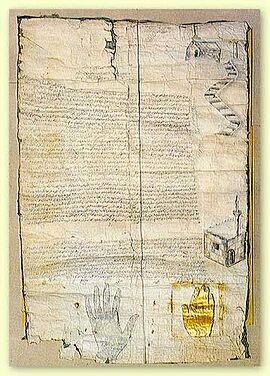
In May 1844 and February 1859, Constantin von Tischendorf visited the monastery for research and discovered the Codex Sinaiticus, dating from the 4th century, at the time the oldest almost completely preserved manuscript of the Bible. The finding from 1859 left the monastery for Russia, in circumstances that had been long disputed. But in 2003 Russian scholars discovered the donation act for the manuscript signed by the Council of Cairo Metochion and Archbishop Callistratus on 13 November 1869. The monastery received 9000 rubles as a gift from Tsar Alexander II of Russia. The Codex was sold by Stalin in 1933 to the British Museum and is now in the British Library, London, where it is on public display. Prior to September 1, 2009, a previously unseen fragment of Codex Sinaiticus was discovered in the monastery's library, as well as among the New Finds of 1975. On other visits (1855, 1857) Constantin von Tischendorf also amassed their more valuable manuscripts (Greek, Christian Palestinian Aramaic, Georgian, Syriac) and took them with him to St. Petersburg and Leipzig, where they are stored today.
In February 1892, Agnes S. Lewis discovered an early palimpsest manuscript of the Gospel in St Catherine Monastery's library that became known as the Syriac Sinaiticus and it remains in the monastery's possession. Agnes and her sister Margaret D. Gibson returned in 1893 with the Cambridge team of the two scholars that included their wives, and also J. Rendel Harris to photograph and transcribe the manuscript in its entirety, as well as to prepare the first catalogues of the Syriac and Arabic manuscripts. Only among the New Finds two additional palimpsest manuscripts came to light containing additional passages of the Old Syriac Gospels.
The Monastery also has a copy of the Ashtiname of Muhammad, in which the Islamic prophet Muhammad is claimed to have bestowed his protection upon the monastery.
Additionally, the monastery houses a copy of Mok'c'evay K'art'lisay, a collection of supplementary books of the Kartlis Cxovreba, dating from the 9th century.
The most important manuscripts have since been filmed or digitized, and so are accessible to scholars. With planning assistance from Ligatus, a research center of the University of the Arts London, the library was extensively renovated, reopening at the end of 2017.
Sinai Palimpsests Project
Since 2011, a team of imaging scientists and experienced scholars in the decipherment of palimpsest manuscripts from the U.S. and Europe have photographed, digitized, and studied the library's collection of palimpsests during the international Sinai palimpsests project.
Palimpsests are notable for having been reused one or more times over the centuries. Since parchment was expensive and time-consuming to produce, monks would erase certain texts with orange juice or scrape them off and write over them. Though the original texts were once assumed to be lost, imaging scientists used narrowband multispectral imaging techniques and technologies to reveal features that were difficult to see with the human eye, including ink residues and small grooves in the parchment. These images have subsequently been digitized and are now freely available for research at the UCLA Online Library for scholarly use.
As of June 2018, at least more than 160 palimpsests were identified, with over 6,800 pages of texts recovered. The newer finds were discovered in a secluded storage area of the St George Tower in 1975. Highlights include "108 pages of previously unknown Greek poems and the oldest-known recipe attributed to the Greek physician Hippocrates;" additional folios for the transmission of the Old Syriac Gospels; two unattested witnesses of an early Christian apocryphal text the Dormition of Mary (Transitus Mariae) of which most of the Greek text is lost; a previously unknown martyrdom of Patriklos of Caesarea Maritima (Israel), one of the eleven followers of Pamphilus of Caesarea; some of the earliest known Georgian manuscripts; as well as insight into dead languages such as the previously hardly attested Caucasian Albanian and Christian Palestinian Aramaic, the local dialect of the early Byzantine period, with many unparalleled text witnesses.
Works of art
The complex houses irreplaceable works of art: mosaics, the best collection of early icons in the world, many in encaustic, as well as liturgical objects, chalices and reliquaries, and church buildings. The large icon collection begins with a few dating to the 5th (possibly) and 6th centuries, which are unique survivals; the monastery having been untouched by Byzantine iconoclasm, and never sacked. The oldest icon on an Old Testament theme is also preserved there. A project to catalogue the collections has been ongoing since the 1960s. The monastery was an important centre for the development of the hybrid style of Crusader art, and retains over 120 icons created in the style, by far the largest collection in existence. Many were evidently created by Latins, probably monks, based in or around the monastery in the 13th century.
Icons
-
The Last Judgement, 11th-12th century, by John Tokhabi
-
13th century Byzantine icon of Saint Michael the Archangel
-
Emperor John VIII Palaiologos
-
Icon of Saint Catherine of Alexandria
-
12th century icon of Saint George and David IV of Georgia
Historical images
-
Carsten Niebuhr (1762)
-
Description de l'Égypte (1809)
-
David Roberts (1839), published in The Holy Land, Syria, Idumea, Arabia, Egypt, and Nubia
Panoramic view
See also
 In Spanish: Monasterio de Santa Catalina del Monte Sinaí para niños
In Spanish: Monasterio de Santa Catalina del Monte Sinaí para niños
- Archbishop of Mount Sinai and Raithu
- Ashtiname of Muhammad
- Caucasian Albanian script
- Charnel House
- Codex Climaci Rescriptus
- Codex Sinaiticus
- Codex Sinaiticus Rescriptus
- Cyril of Jerusalem
- Desert fathers
- Gregory of Sinai
- John Climacus
- Ladder of Divine Ascent
- Oldest churches in the world
- Martyrs of Palestine
- Poustinia
- Sinaites in Serbia
- Syriac Sinaiticus
- Transitus Mariae


